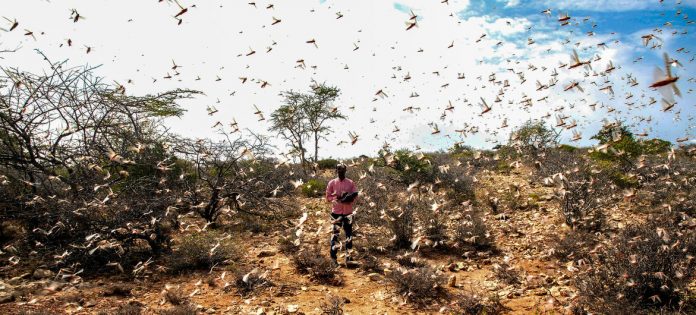New Desert Locust swarms are forming in the Horn of Africa, threatening agricultural livelihoods and the food security of millions of people, the UN Food and Agriculture Organization (FAO) warned on Wednesday.
According to the agency, locust infestations increased over the past month in Ethiopia and Somalia as a result of extensive breeding, favourable weather and rainfall, with populations predicted to increase further in the coming months.
“New locust swarms are already forming and threatening to re-invade northern Kenya and breeding is also underway on both sides of the Red Sea, posing a new threat to Eritrea, Saudi Arabia, the Sudan, and Yemen,” FAO said in a news release.
The greater Horn of Africa region witnessed one of its worst ever Desert Locust infestations, earlier this year. A new crisis could have devastating consequenes for communities affected by recurrent drought, conflict, high food prices, and the coronavirus pandemic.
Battle ‘not yet over’
The upsurge occurred in spite of an unprecedented campaign supported by FAO and partners, in which more than 1.3 million hectares of locust infestations were treated across ten countries this year.
Control operations prevented the loss of an estimated 2.7 million tonnes of cereal, enough to feed 18 million people a year, in countries already hard hit by acute food insecurity and poverty.
FAO Director-General Qu Dongyu highlighted the achievements but warned that the “battle against the relentless pest is not yet over.”
“We must not waiver. Locusts keep growing day and night and risks are exacerbating food insecurity for vulnerable families across the affected region,” he added.
Protecting livelihoods
FAO, for its part, is assisting governments and partners with monitoring and coordination, technical advice and the procurement of supplies and equipment. It is also supporting rural livelihoods by providing affected communities with farming packages, veterinary care and feed for vegetation-starved livestock, and cash for families who have lost their crops so that they can cope until their next harvest.
However, efforts must be scaled up to protect food production and prevent worsening food insecurity in the affected countries.
The UN agency requires a further $40 million to increase surveillance and control activities in the worst affected countries – Ethiopia, Kenya, Somalia, the Sudan, and Yemen – next year.
Without additional funding, control efforts could slow down or halt from the end of January 2021, potentially allowing the numbers of the crop-devouring pest to surge in some places, it warned.
“Farmers, whose livelihoods have been impacted, require further support and national capacities in monitoring and responding to Desert Locust still need to be strengthened.”
Source: UN News






























